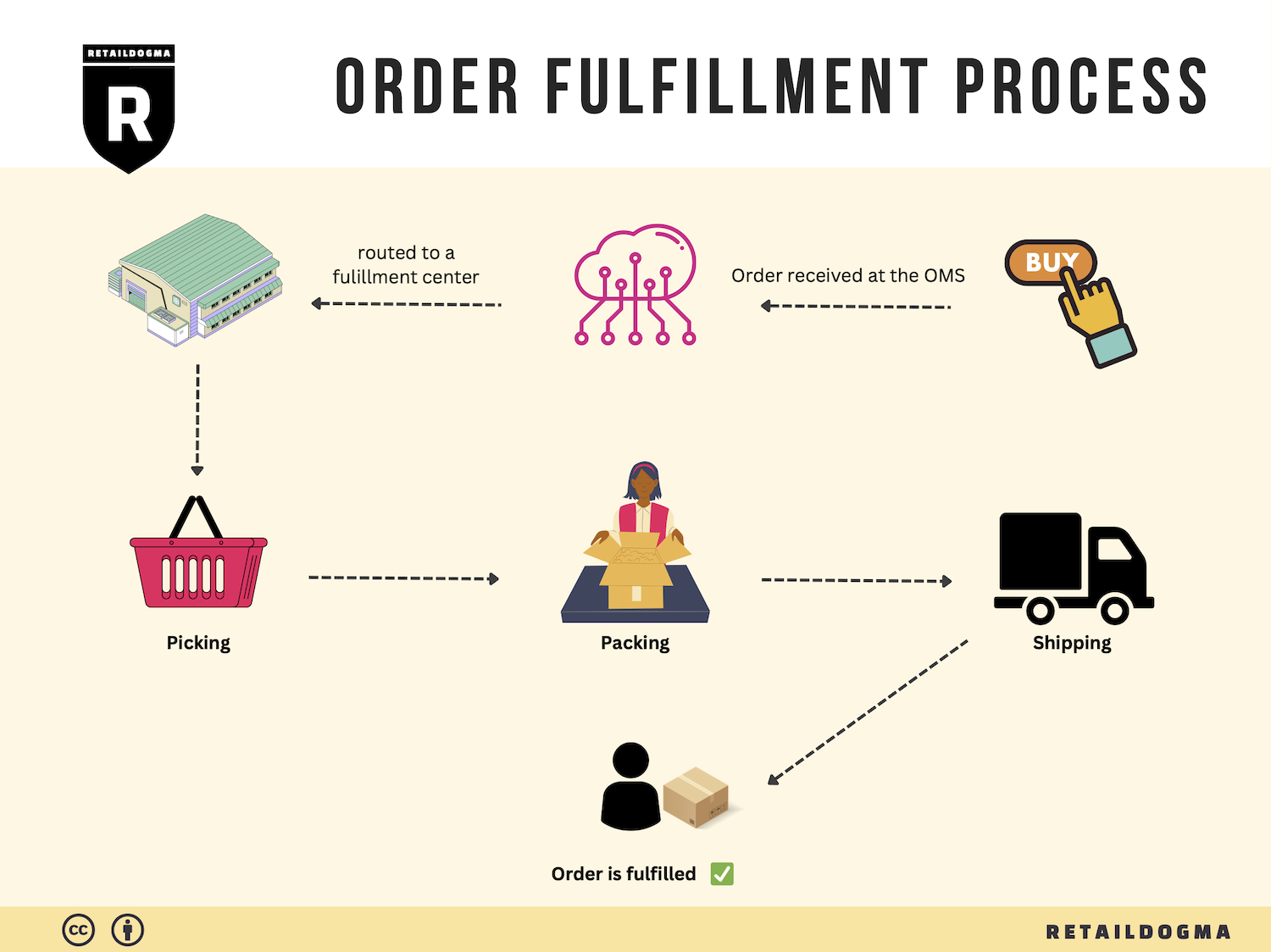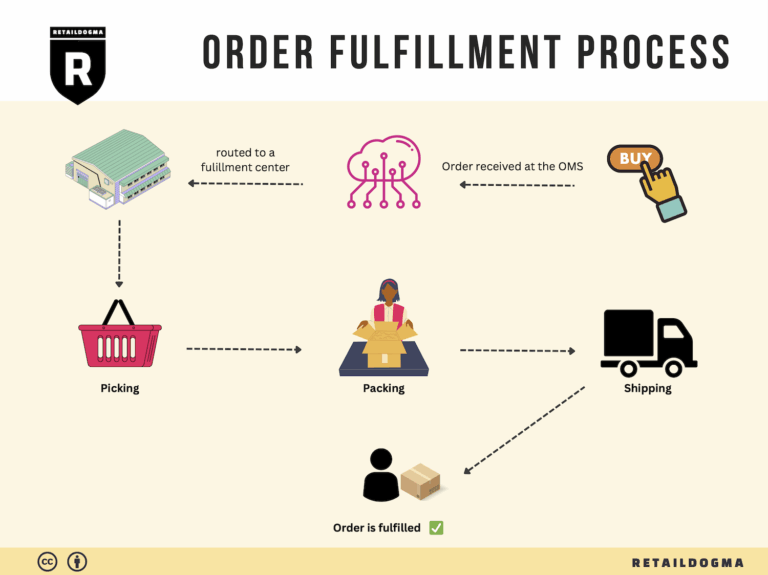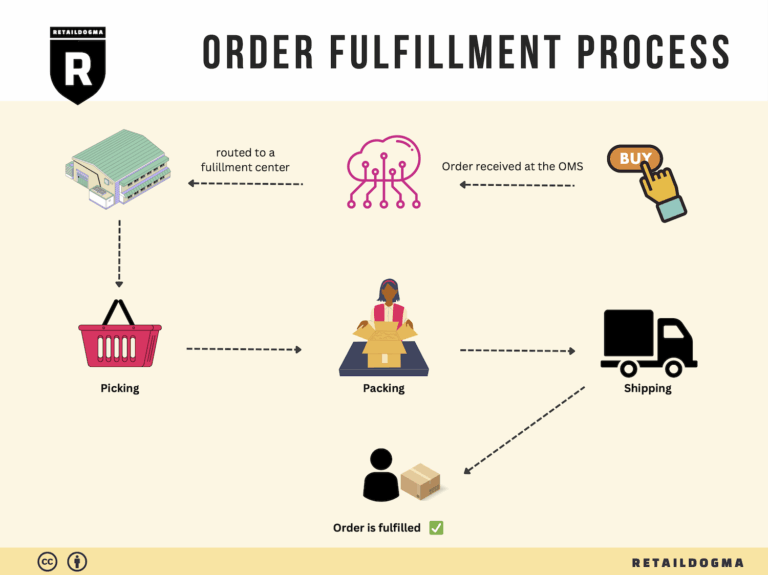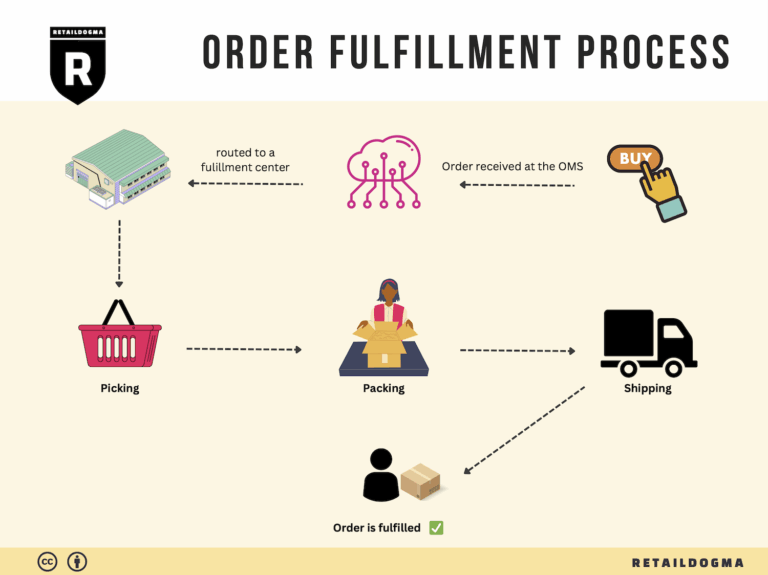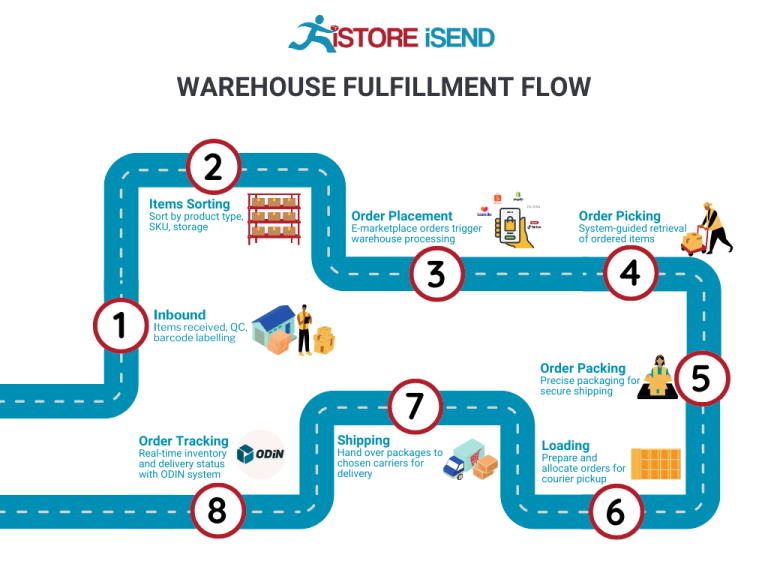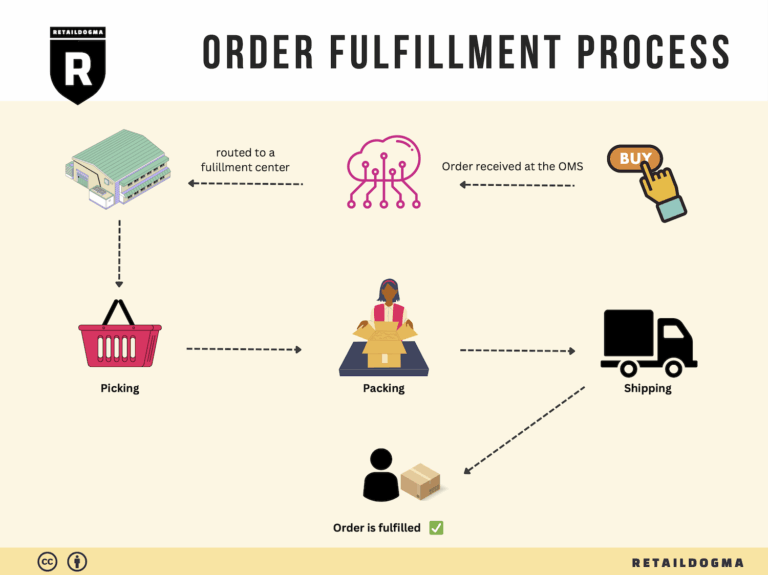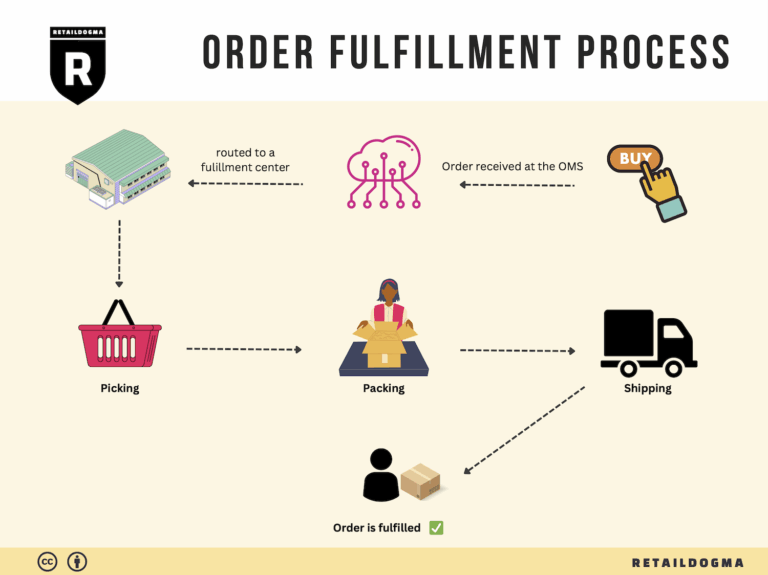How Order Fulfillment Works: A Step-by-Step Guide for Businesses
What is E-commerce Fulfillment? An Introduction for Growing Businesses
Understanding the Challenges of E-commerce Fulfillment
As a growing online business owner, you might find yourself overwhelmed with the logistics of packing and shipping orders. The excitement of increasing sales can quickly turn into stress as you grapple with inventory management, shipping timelines, and customer expectations. This is where e-commerce fulfillment comes into play. Simply put, fulfillment is the process of getting a product from your shelves to your customers’ doorsteps. It encompasses everything from receiving and storing inventory to picking, packing, and shipping orders.
The Importance of Efficient Fulfillment
Efficient fulfillment is crucial for maintaining customer satisfaction and driving repeat business. Delays in shipping or errors in order fulfillment can lead to negative reviews and lost sales. As your business scales, it becomes increasingly important to streamline these processes to focus on growth rather than getting bogged down in logistics.
What This Guide Will Cover
In this guide, we will explore various aspects of e-commerce fulfillment to help you navigate this critical component of your business. We’ll discuss different fulfillment models, including Third-Party Logistics (3PL) and Fulfillment by Amazon (FBA), so you can understand which might be the best fit for your needs.
You will also learn about the core services offered by fulfillment partners, such as inventory management, order processing, and customer service support. Understanding these services is key to selecting the right partner who can accommodate your specific requirements as your business grows.
Choosing the Right Fulfillment Partner
Choosing a fulfillment partner is one of the most significant decisions you will make as a business owner. Factors to consider include the partner’s reliability, technology infrastructure, and ability to scale alongside your business. We will provide practical insights on how to evaluate potential partners and what questions to ask to ensure a successful collaboration.
Pricing Considerations
Finally, we will delve into pricing structures associated with various fulfillment services. Understanding the costs involved will enable you to budget effectively and make informed decisions that align with your business goals.
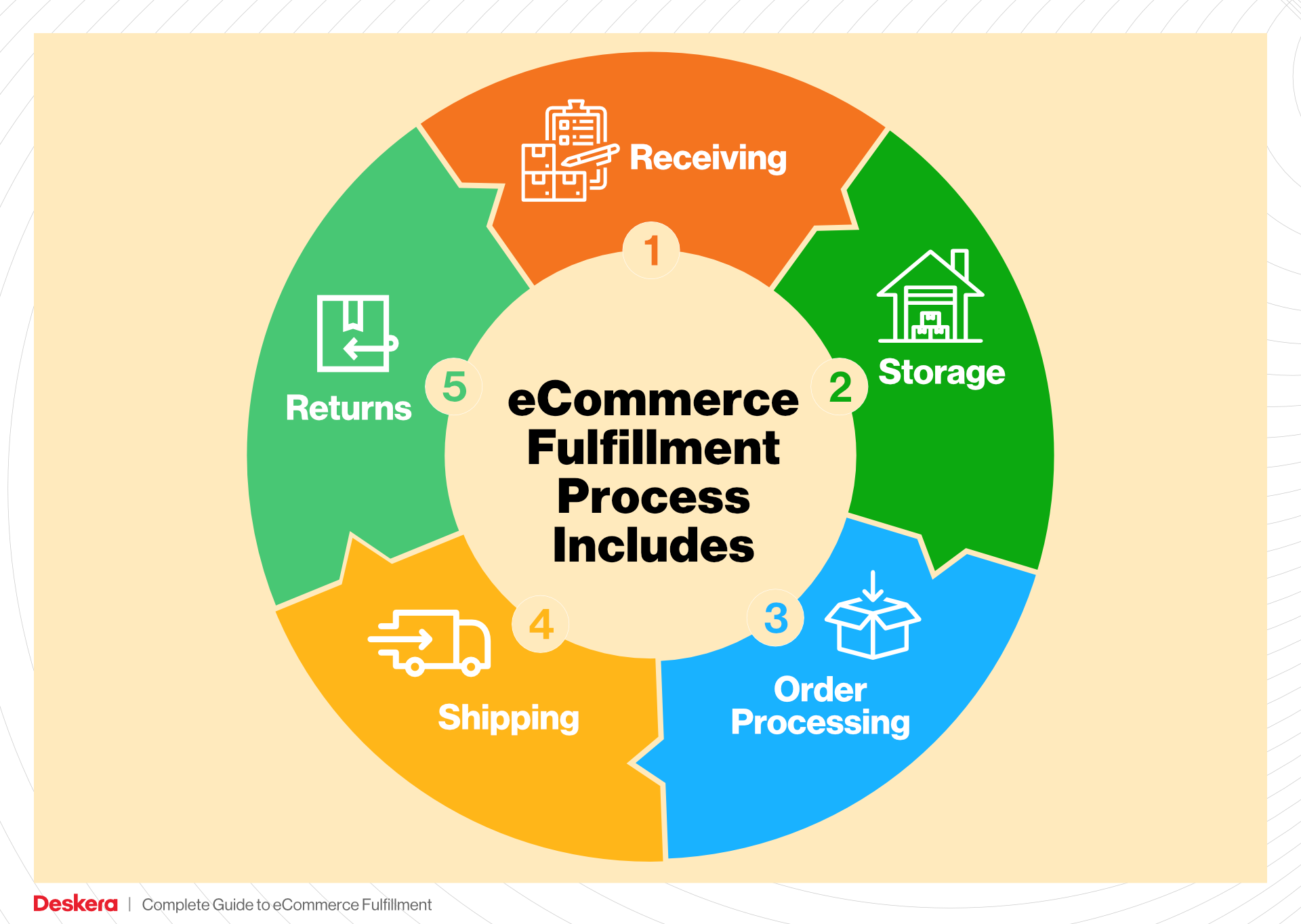
Empowering Smart Logistics Decisions
The goal of this guide is to empower you with the knowledge necessary to make smart decisions about your logistics. By understanding the intricacies of e-commerce fulfillment, you can enhance operational efficiency, improve customer satisfaction, and ultimately drive the growth of your online business. Let’s get started on this journey to mastering e-commerce fulfillment!
What You’ll Learn In This Guide
- What is E-commerce Fulfillment? An Introduction for Growing Businesses
- The Order Fulfillment Process: From ‘Buy’ Button to Customer’s Door
- Comparing Fulfillment Models: In-House vs. 3PL vs. Dropshipping
- A Deep Dive into Amazon FBA: Pros, Cons, and Who It’s For
- Core Services Offered by Fulfillment Centers
- How to Choose a Fulfillment Partner: A 6-Point Checklist
- Understanding Fulfillment Pricing: A Breakdown of Common Fees
- Frequently Asked Questions (FAQs) about Fulfillment
- Conclusion: Is Outsourcing Fulfillment the Right Move for Your Business?
- Important Disclaimer
The Order Fulfillment Process: From ‘Buy’ Button to Customer’s Door
1. Receiving Inventory
The order fulfillment process begins with receiving inventory, a critical step where products are checked upon arrival at the fulfillment center. During this phase, items are counted, inspected for quality, and matched against purchase orders. This process ensures that the right products are in the right quantities and that they are in sellable condition. A key term associated with this step is SKU (Stock Keeping Unit), which is a unique identifier for each product that helps in tracking and managing inventory efficiently.
This step is crucial because any discrepancies in inventory can lead to stockouts or overstock situations, both of which can negatively impact sales and customer satisfaction. Effective inventory management right from the start lays the foundation for a smooth fulfillment process and helps maintain optimal stock levels.
2. Warehouse Storage
Once the inventory is received, the next step is warehouse storage. This involves organizing products in designated areas within the fulfillment center. Efficient storage solutions—such as shelving units, bins, and pallets—are employed to maximize space and facilitate easy access. This process is often guided by principles of ABC analysis, which categorizes inventory based on sales volume, allowing for strategic placement of high-demand items in easily accessible locations.
Proper warehouse storage is essential for minimizing retrieval times during order fulfillment. A well-organized warehouse can significantly enhance operational efficiency, reduce labor costs, and improve order accuracy. Moreover, maintaining an organized storage system helps in quickly identifying products during inventory audits, ensuring that stock levels are always up-to-date.
3. Order Picking
The third step in the fulfillment process is order picking, where items are retrieved from their storage locations to fulfill customer orders. This process can be executed using various methods, including pick lists, which are documents that outline the specific items and quantities needed for each order. Technologies such as barcode scanning or pick-to-light systems can further streamline this process, enhancing speed and accuracy.
Order picking is vital because it directly affects the speed at which orders are processed and shipped. Inefficient picking processes can lead to delays, which in turn can harm customer satisfaction and loyalty. By optimizing order picking, businesses can ensure that orders are filled correctly and quickly, which is especially important in today’s fast-paced e-commerce environment.
4. Order Packing
After items are picked, they move to the order packing stage. Here, products are carefully packaged to ensure they arrive at the customer’s doorstep in perfect condition. This includes selecting appropriate packaging materials, such as boxes, padding, and protective wraps, and including necessary documentation like invoices and return labels. A key term in this step is packing slip, which provides a summary of the items included in the shipment.
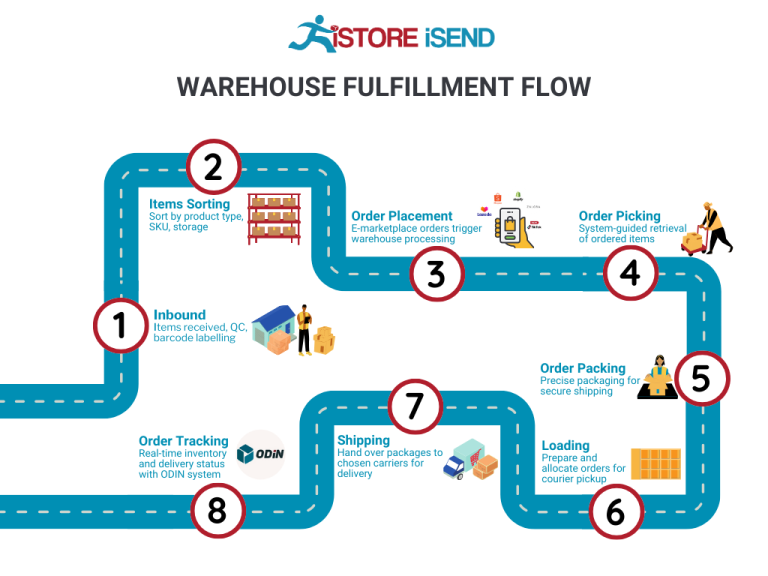
The importance of order packing cannot be overstated. Properly packed orders reduce the risk of damage during transit and enhance the overall customer experience. Additionally, efficient packing processes can help minimize shipping costs by optimizing package size and weight, which is crucial for maintaining profitability in a competitive marketplace.
5. Shipping & Delivery
The final step in the fulfillment process is shipping and delivery. Once orders are packed, they are labeled and handed over to shipping carriers for delivery to customers. This step involves selecting the most cost-effective and timely shipping options based on customer preferences and delivery locations. Key terms associated with this stage include last-mile delivery, which refers to the final leg of the shipping journey to the customer’s home.
Shipping and delivery are critical for customer satisfaction, as they determine how quickly and reliably customers receive their orders. Businesses must continuously evaluate their shipping strategies, considering factors like carrier performance, delivery times, and costs. By optimizing shipping and delivery processes, companies can not only enhance customer satisfaction but also reduce operational costs, leading to improved overall efficiency in the fulfillment process.
By understanding and effectively managing each of these five steps, e-commerce businesses can streamline their order fulfillment processes, improve operational efficiency, and ultimately drive customer satisfaction and loyalty.
Comparing Fulfillment Models: In-House vs. 3PL vs. Dropshipping
Comparison of Fulfillment Models
| Model | Who Handles Inventory | Best For (Business Stage) | Key Advantage | Key Disadvantage |
|---|---|---|---|---|
| In-House Fulfillment | Business itself | Established businesses with stable demand | Full control over inventory and operations | High overhead costs, including labor and warehousing |
| Third-Party Logistics (3PL) | Outsourced to a logistics provider | Growing businesses looking to scale | Access to expert logistics and reduced complexity | Potential loss of control over inventory and customer experience |
| Dropshipping | Supplier or manufacturer | Startups and small businesses | Low overhead and no inventory risk | Lower profit margins and dependency on suppliers |
In-House Fulfillment
In-house fulfillment involves managing all aspects of warehousing, inventory management, and shipping within the business itself. This model is typically best suited for established businesses that have a stable demand and sufficient resources to handle logistics internally. The primary advantage of in-house fulfillment is the level of control it offers over inventory and operations. Businesses can directly manage the quality of their products, streamline their order processing, and tailor their shipping methods to meet customer expectations. However, this model comes with significant disadvantages, including high overhead costs associated with labor, warehouse space, and equipment. As a business grows, the complexity of managing these operations can lead to inefficiencies and increased operational burdens.
Third-Party Logistics (3PL)
Third-party logistics (3PL) providers offer businesses the ability to outsource their fulfillment operations. This model is particularly beneficial for growing businesses that are looking to scale without the burden of managing their logistics in-house. By partnering with a 3PL, companies can leverage the provider’s expertise in logistics, technology, and shipping, allowing them to focus on their core business activities. The key advantage of using a 3PL is the reduction in complexity and operational burden, as these providers typically handle warehousing, inventory management, and shipping. However, a major drawback is the potential loss of control over inventory and the customer experience. Businesses may find it challenging to maintain brand consistency and quality assurance when relying on an external provider for fulfillment.
Dropshipping
Dropshipping is a fulfillment model where the retailer does not hold inventory but instead relies on suppliers or manufacturers to ship products directly to customers. This model is ideal for startups and small businesses that want to minimize upfront costs and inventory risks. The primary advantage of dropshipping is the low overhead, as businesses do not need to invest in warehouse space or inventory management. Additionally, dropshipping allows for a wide range of product offerings without the need for upfront investment. However, the model comes with notable disadvantages, including lower profit margins and a heavy reliance on suppliers. Retailers may face challenges with shipping times, product quality, and customer service, as they have limited control over these aspects. Furthermore, issues such as stock shortages or shipping delays can directly impact customer satisfaction and brand reputation.
Conclusion
Choosing the right fulfillment model is critical for e-commerce businesses, as it directly affects operational efficiency, customer satisfaction, and scalability. Each model—whether in-house fulfillment, 3PL, or dropshipping—has its unique set of advantages and disadvantages. Business owners must assess their specific needs, resources, and growth objectives to determine which fulfillment strategy aligns best with their overall business goals. By understanding these models, entrepreneurs can make informed decisions that will support their operational needs and drive sustainable growth.
A Deep Dive into Amazon FBA: Pros, Cons, and Who It’s For
Understanding Fulfillment by Amazon (FBA)
Fulfillment by Amazon (FBA) is a service offered by Amazon that allows sellers to store their products in Amazon’s fulfillment centers. Amazon then takes care of storage, packaging, shipping, and customer service on behalf of the sellers. This service is particularly appealing for e-commerce businesses looking to streamline their operations and scale their sales effectively.
When a customer orders a product through Amazon, the order is processed through Amazon’s system. The product is picked from the seller’s inventory stored in an Amazon fulfillment center, packaged, and shipped directly to the customer. Additionally, Amazon handles returns and provides customer service, which can significantly reduce the workload for sellers.
How FBA Works
-
Registration and Setup: Sellers must create an Amazon seller account and enroll in the FBA program. This involves setting up shipping plans to send inventory to Amazon’s warehouses.
-
Inventory Management: Sellers ship their products to Amazon’s fulfillment centers. Amazon provides guidelines on how to prepare and label products correctly to ensure they are stored and shipped efficiently.
-
Storage: Once the inventory arrives at the fulfillment center, it is stored until sold. Amazon uses advanced technology to manage inventory and ensure efficient storage.
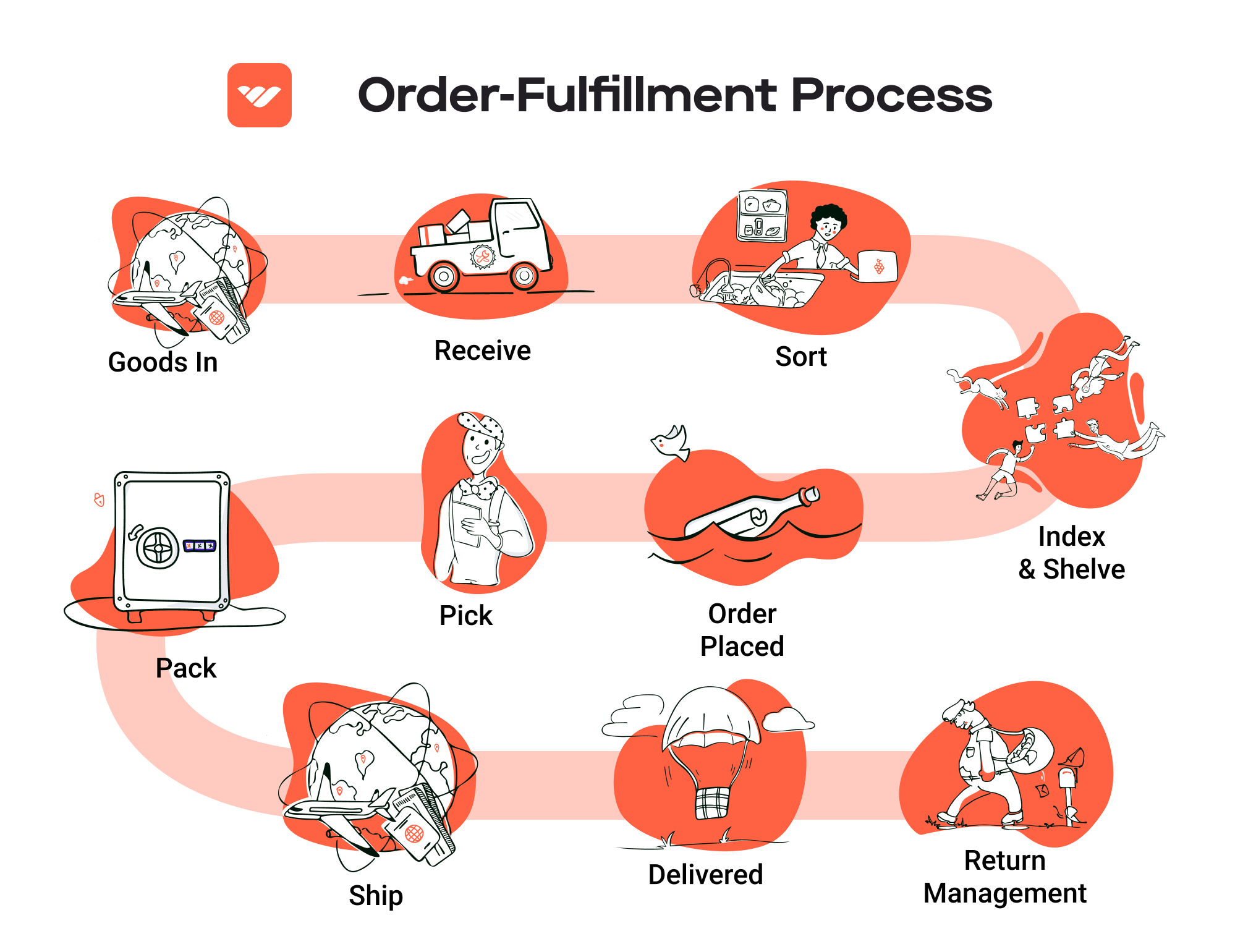
-
Order Fulfillment: When a customer places an order, Amazon picks the item from storage, packs it, and ships it directly to the customer. Sellers can monitor their inventory levels and sales through the Amazon seller dashboard.
-
Customer Service: Amazon handles all customer inquiries and returns, allowing sellers to focus on their business without worrying about post-sale support.
-
Payment: Sellers receive payments for sales made through FBA, minus Amazon’s fees, which are deducted from the total sales amount.
Pros of Using FBA
-
Prime Eligibility: Products fulfilled by Amazon automatically qualify for Amazon Prime, giving sellers access to millions of Prime members who are more likely to purchase due to the expedited shipping options. This can significantly increase sales volume.
-
Customer Trust: Amazon’s reputation for reliable shipping and customer service extends to FBA sellers. Customers are more likely to buy from sellers using FBA because they trust Amazon’s brand.
-
Multi-Channel Fulfillment: FBA allows sellers to use Amazon’s fulfillment services for orders placed on other platforms, such as eBay or their own website. This flexibility can streamline operations across multiple sales channels.
-
Scalability: FBA enables sellers to scale their businesses without the need to invest heavily in warehousing or logistics infrastructure. As sales grow, Amazon can handle the increased volume seamlessly.
-
Time Savings: By outsourcing fulfillment, sellers can focus on marketing, product development, and other critical areas of their business, rather than managing logistics.
Cons of Using FBA
-
High Fees: While FBA offers many benefits, it also comes with costs. Sellers incur fees for storage, fulfillment, and other services. These fees can add up, particularly for low-margin products, and must be carefully managed to maintain profitability.
-
Strict Inventory Rules: Amazon has stringent inventory management policies. Sellers must adhere to guidelines regarding product preparation, labeling, and shipping. Failure to comply can lead to additional fees or even inventory removal.
-
Commingling Risks: Amazon may commingle inventory from different sellers, meaning products from different sellers could be stored together. This can lead to issues if a customer receives the wrong product or if a seller’s inventory is damaged or lost. Sellers must weigh the risks associated with this practice.
-
Limited Control Over Shipping: While Amazon handles logistics, sellers have limited control over shipping times and methods. This can be a disadvantage if sellers want to offer specific shipping options or faster delivery times.
-
Account Management Challenges: Sellers are subject to Amazon’s policies and can face account suspensions or restrictions if they fail to meet performance metrics. This can create stress and uncertainty for business owners.
Who is FBA Best For?
Fulfillment by Amazon is particularly well-suited for certain types of sellers:
-
Small to Medium-Sized Businesses: Sellers looking to grow without investing heavily in logistics infrastructure can benefit significantly from FBA’s scalability.
-
Sellers with High Volume: Businesses with a large volume of sales can take advantage of FBA’s efficiencies and reduce per-unit fulfillment costs.
-
New Sellers: Entrepreneurs new to e-commerce can leverage FBA to gain immediate access to Amazon’s customer base and logistical expertise, which can help them establish their brand more quickly.
-
Sellers of Consumables or Fast-Moving Goods: Businesses that sell items with high turnover rates can maximize the benefits of FBA, as the service is designed to facilitate quick order fulfillment.
-
Multi-Channel Retailers: Sellers looking to streamline operations across various platforms can use FBA to manage fulfillment for orders from multiple channels efficiently.
In conclusion, Fulfillment by Amazon offers a powerful solution for e-commerce sellers looking to enhance their operations and scale their businesses. While it comes with its challenges, the benefits of increased visibility, customer trust, and operational efficiency can make it a worthwhile investment for many sellers.
Core Services Offered by Fulfillment Centers
Inventory Management & Warehousing
Effective inventory management is foundational for e-commerce success. Fulfillment centers offer sophisticated warehousing solutions that enable businesses to store products in strategically located facilities. This not only reduces shipping times but also enhances customer satisfaction.
What It Is:
Inventory management involves tracking stock levels, orders, sales, and deliveries. Fulfillment centers utilize advanced software systems to monitor inventory in real-time, ensuring that businesses have the right amount of stock available to meet customer demand without overstocking.
Benefits:
1. Improved Stock Control: Businesses can maintain optimal stock levels, reducing the risk of stockouts or excess inventory, which can tie up capital.
2. Enhanced Visibility: Real-time inventory tracking provides insights into sales trends and customer preferences, allowing for more informed purchasing decisions.
3. Cost Efficiency: Centralized storage reduces costs associated with multiple warehouses and enables bulk purchasing, which can lower unit costs.
4. Scalability: As your business grows, fulfillment centers can accommodate increased inventory needs without the logistical headaches of managing storage space.
Pick and Pack Services
The pick and pack service is crucial for streamlining order fulfillment. This process involves selecting the ordered items from inventory and packing them for shipment.
What It Is:
Fulfillment centers employ dedicated staff and automated systems to accurately pick items from the warehouse shelves and pack them according to the specific requirements of each order. This includes selecting appropriate packaging materials to ensure products arrive safely at their destination.
Benefits:
1. Increased Efficiency: Automated systems can significantly speed up the picking and packing process, reducing order lead times and improving overall operational efficiency.
2. Accuracy and Quality Control: Advanced technology and trained staff minimize picking errors, ensuring that customers receive exactly what they ordered, which enhances customer trust and satisfaction.
3. Custom Packaging Options: Fulfillment centers often provide customized packing solutions, including branded packaging, which can enhance the customer experience and promote brand identity.
4. Scalability: Whether you have a seasonal spike in orders or a consistent volume, fulfillment centers can adjust their operations to meet your needs without compromising service quality.
Kitting and Assembly
Kitting and assembly services enable e-commerce businesses to offer bundled products or kits, providing customers with a convenient shopping experience.
What It Is:
This service involves assembling multiple products into a single package or kit. For instance, a fulfillment center might bundle a toy set with additional accessories and package them together for sale.
Benefits:
1. Enhanced Product Offerings: Kitting allows businesses to create unique product offerings that can attract more customers and differentiate them from competitors.
2. Increased Average Order Value: Bundled products often encourage customers to purchase more, thereby increasing the average order value and overall sales.
3. Simplified Logistics: By consolidating multiple items into one shipment, businesses can reduce shipping costs and simplify their supply chain logistics.
4. Improved Customer Experience: Offering pre-assembled kits can save customers time and effort, enhancing their shopping experience and increasing the likelihood of repeat purchases.
Returns Management (Reverse Logistics)
Returns management, or reverse logistics, is a critical service provided by fulfillment centers that ensures the efficient handling of product returns.
What It Is:
This process involves managing the return of products from customers back to the fulfillment center. It includes assessing the returned items, processing refunds or exchanges, and restocking items as needed.
Benefits:
1. Streamlined Returns Process: Fulfillment centers have established systems for managing returns efficiently, which can significantly reduce the administrative burden on e-commerce businesses.
2. Customer Retention: A smooth and hassle-free return process can enhance customer satisfaction, increasing the likelihood of repeat business and positive reviews.
3. Data Insights: Analyzing return data can provide valuable insights into product quality, customer preferences, and potential improvements in product offerings.
4. Sustainability Practices: Many fulfillment centers are now adopting sustainable practices in handling returns, such as refurbishing or recycling items, which can enhance a company’s brand image and appeal to environmentally conscious consumers.
In conclusion, partnering with a fulfillment center can provide e-commerce businesses with essential services that enhance operational efficiency, improve customer satisfaction, and ultimately drive growth. By leveraging these core services, businesses can focus on scaling their operations while leaving the complexities of logistics and fulfillment to the experts.
How to Choose a Fulfillment Partner: A 6-Point Checklist
Location & Warehouse Network
Importance:
The geographical location of your fulfillment partner’s warehouses is crucial. Proximity to your customer base can significantly affect shipping times and costs. A partner with a well-distributed network can facilitate faster deliveries and reduce shipping expenses.
Questions to Ask:
– Where are your warehouses located, and how does this align with my customer demographics?
– Do you have facilities in regions where I plan to expand my sales?
– How do you manage inventory across multiple locations?
Technology & Integrations
Importance:
In today’s e-commerce landscape, technology is a key driver of efficiency. Your fulfillment partner should provide robust technology platforms that integrate seamlessly with your e-commerce systems. This ensures real-time inventory tracking, order processing, and visibility into fulfillment operations.
Questions to Ask:
– What technology do you use to manage inventory and orders?
– Can your system integrate with my existing e-commerce platform (e.g., Shopify, WooCommerce, eBay)?
– How do you handle updates and maintenance of your technology systems?
Specializations (e.g., cold storage, oversized items)
Importance:
Different businesses have unique needs. If your products require special handling, such as temperature-controlled storage or handling oversized items, it’s essential to partner with a fulfillment center that specializes in these areas.
Questions to Ask:
– Do you have experience handling products similar to mine?
– What special services do you offer (e.g., cold storage, hazardous materials, oversized items)?
– How do you ensure compliance with regulations related to specialized storage?
Scalability & Capacity
Importance:
As your business grows, so will your fulfillment needs. A suitable partner should be able to scale operations seamlessly to accommodate increased order volumes during peak seasons or as your business expands.
Questions to Ask:
– What is your current capacity for handling orders, and how can this scale as my business grows?
– How do you manage peak season demands?
– Can you provide examples of how you’ve scaled operations for other clients?
Pricing and Contracts
Importance:
Understanding the pricing structure and contract terms is vital to avoid unexpected costs that can erode your margins. Look for transparency in pricing and flexible contract terms that accommodate your growth.
Questions to Ask:
– How is your pricing structured (e.g., per order, per item, storage fees)?
– Are there any additional fees (e.g., handling, returns, packaging)?
– What is the length of your contracts, and what are the terms for termination or renewal?
Customer Support & Reviews
Importance:
Reliable customer support is essential for addressing issues that may arise during the fulfillment process. Additionally, researching reviews and testimonials can provide insights into the partner’s reliability and service quality.
Questions to Ask:
– What support options do you offer (e.g., phone, email, live chat)?
– Can you provide references or case studies from other clients?
– How do you handle disputes or service failures, and what is your typical response time?
Conclusion
Choosing the right fulfillment partner is a critical decision that can impact your e-commerce business’s efficiency, customer satisfaction, and ultimately, its success. By carefully considering the six points outlined in this checklist, you can make an informed decision that aligns with your business goals and customer expectations. Remember that the right partner will not only meet your current needs but also support your growth ambitions in the ever-evolving e-commerce landscape.
Understanding Fulfillment Pricing: A Breakdown of Common Fees
Initial Setup Fees
When partnering with a fulfillment center like Orange Connex, the first cost you may encounter is the initial setup fee. This fee typically covers the administrative work required to onboard your business, including setting up your account, integrating your e-commerce platform, and configuring your inventory management system.
The calculation of setup fees can vary widely based on the complexity of your operations and the specific services offered by the fulfillment provider. For example, if you require custom packaging or unique software integrations, the setup fee could be higher. Businesses should expect to pay anywhere from a few hundred to several thousand dollars, depending on their specific needs and the provider’s pricing structure.
Receiving Fees
Receiving fees are charged for the process of accepting and logging your inventory into the fulfillment center. This includes unloading goods from delivery trucks, inspecting shipments for damage, and entering the inventory into the system.
Typically, these fees are calculated per shipment and can range from a flat fee for small shipments to a per-unit fee for larger quantities. For instance, a fulfillment center might charge $25 for receiving a small shipment of 10 boxes, while larger shipments might incur a per-item fee of $0.50. To manage these costs effectively, businesses should consider consolidating shipments to minimize the frequency of receiving fees.
Storage Fees (per pallet/bin)
Storage fees are charged for the space your products occupy within the fulfillment center. These fees are typically assessed on a monthly basis and can be calculated per pallet or per bin, depending on how your inventory is organized.
For instance, a fulfillment center may charge $10 per pallet per month or $5 per bin. The actual cost will depend on the location and size of the warehouse, as well as demand for storage space. Businesses should aim to maintain an efficient inventory turnover to minimize storage costs, as excess inventory can quickly lead to higher fees.
Pick & Pack Fees (per item/order)
Pick and pack fees are incurred each time an order is processed. This fee covers the costs associated with selecting items from inventory (picking), packing them for shipment, and preparing them for delivery.
These fees are often calculated on a per-item or per-order basis. For example, a fulfillment center may charge $1.00 for each item picked and packed, or a flat fee of $3.00 per order, regardless of the number of items. Businesses can optimize their pick and pack fees by streamlining their product offerings or using kitting services, where items are grouped together for faster processing.
Shipping Fees
Shipping fees are a significant component of fulfillment costs and can vary based on several factors, including the weight and dimensions of the package, the shipping method selected, and the destination. Fulfillment centers typically negotiate shipping rates with carriers, allowing them to pass on savings to their clients.
Shipping fees can be calculated using a tiered pricing model based on weight or a flat rate for specific service levels (e.g., standard, expedited). For example, shipping a package weighing less than 1 lb may cost $5, while packages over 5 lbs could incur charges of $10 or more. Businesses should consider utilizing multiple carriers to find the most cost-effective shipping options for their needs.
Tips for Getting an Accurate Quote
To obtain an accurate quote from a fulfillment provider like Orange Connex, consider the following tips:
-
Detail Your Needs: Clearly outline your business model, expected order volume, and specific services required. This information will help the provider tailor their quote to your unique situation.
-
Compare Pricing Structures: Look for transparency in pricing and compare quotes from multiple fulfillment centers to ensure you’re getting a competitive rate.
-
Ask About Additional Fees: Inquire about any potential hidden fees, such as those for returns, special handling, or seasonal surcharges.
-
Consider Long-Term Contracts: Some providers offer discounts for long-term commitments, which can significantly reduce overall costs.
-
Utilize Technology: Leverage technology and software solutions that can integrate with the fulfillment provider’s systems to streamline operations and reduce costs.
By understanding these common fulfillment pricing models and following these tips, e-commerce business owners can make informed decisions that enhance their logistics strategies and support their growth objectives.
Frequently Asked Questions (FAQs) about Fulfillment
1. What is the Orange Connex Fulfillment Center?
Orange Connex Fulfillment Center is a logistics and fulfillment service provider that specializes in e-commerce. It was established to offer advanced supply chain solutions, enabling businesses to efficiently manage inventory, order processing, and shipping, particularly for cross-border transactions.
2. How does the Orange Connex fulfillment process work?
The fulfillment process at Orange Connex involves several steps:
1. Inventory Management: Businesses send their products to the fulfillment center.
2. Order Processing: When a customer places an order, the fulfillment center picks, packs, and prepares the item for shipment.
3. Shipping: Orders are shipped using various carriers, ensuring timely delivery based on customer preferences and regional requirements.
4. Tracking: Both businesses and customers can track shipments in real-time for better visibility.
3. What is the difference between a warehouse and a fulfillment center?
A warehouse is primarily a storage facility where goods are kept until they are needed. In contrast, a fulfillment center goes beyond storage; it handles the entire order processing workflow, including picking, packing, and shipping products directly to customers. Fulfillment centers are optimized for e-commerce operations to enhance speed and efficiency.
4. What is a Third-Party Logistics Provider (3PL)?
A Third-Party Logistics Provider (3PL) is a company that offers outsourced logistics services, including transportation, warehousing, and order fulfillment. Businesses partner with 3PLs like Orange Connex to leverage their expertise, technology, and resources, allowing them to focus on core operations while improving their supply chain efficiency.
5. How much do fulfillment services cost?
The cost of fulfillment services varies based on several factors, including order volume, storage space required, and specific services needed (like packaging and shipping). Generally, businesses can expect to pay for storage fees per pallet or cubic foot, picking and packing fees per order, and shipping costs based on weight and destination. It’s advisable to request a detailed quote from Orange Connex to understand the full pricing structure.
6. What shipping options does Orange Connex offer?
Orange Connex provides a variety of shipping options tailored to meet customer needs, including standard, expedited, and international shipping. The platform connects businesses with multiple carriers, allowing for competitive rates and delivery times. Businesses can customize their shipping choices based on customer expectations and regional logistics requirements.
7. How can I track my orders with Orange Connex?
Customers can track their orders through the tracking information provided by Orange Connex at the time of shipment. The platform offers real-time tracking capabilities, allowing both businesses and customers to monitor the status of their shipments, ensuring transparency and timely updates.
8. Can I integrate Orange Connex with my e-commerce platform?
Yes, Orange Connex supports integration with various e-commerce platforms, enabling seamless order management and fulfillment processes. This integration allows businesses to automate order processing, inventory updates, and shipping notifications, enhancing operational efficiency.
9. What kind of support does Orange Connex provide?
Orange Connex is committed to providing excellent customer service, with a reported satisfaction rate of 98.6%. They offer support through various channels, including dedicated account managers, online resources, and customer service teams to assist with any inquiries or issues related to fulfillment.
10. How can I get started with Orange Connex Fulfillment Services?
To get started with Orange Connex, businesses can visit their website and fill out an inquiry form or request a consultation. The team will guide you through the onboarding process, including assessing your needs, setting up your account, and integrating your e-commerce platform for optimal fulfillment management.
Conclusion: Is Outsourcing Fulfillment the Right Move for Your Business?
Assessing the Value of Outsourcing Fulfillment
Outsourcing fulfillment can be a game-changer for e-commerce businesses seeking to scale efficiently. By leveraging a specialized fulfillment service like Orange Connex, you can save valuable time that would otherwise be spent managing logistics, allowing you to focus on core business activities such as marketing and customer engagement. This time savings not only enhances productivity but also accelerates your ability to respond to market changes and customer demands.
Scalability is another significant advantage. As your business grows, so do the complexities of order fulfillment. A capable partner can provide the infrastructure and resources necessary to handle increased order volumes seamlessly. This ensures that your business can grow without the typical growing pains associated with logistics management, such as hiring and training new staff or investing in additional warehousing space.
Moreover, partnering with an expert in the field brings invaluable knowledge of best practices, technology integrations, and market trends. With a dedicated fulfillment partner, you gain access to sophisticated logistics solutions and a network of carriers, which can enhance your delivery speed and reduce costs. This expertise translates into a better customer experience, fostering loyalty and repeat business.
However, the success of outsourcing fulfillment hinges on selecting the right partner. Conduct thorough due diligence to ensure that the service provider aligns with your business goals and can meet your specific needs.
As a strategic next step, consider auditing your current shipping process. Evaluate areas for improvement and determine whether a fulfillment partner could enhance your operational efficiency and customer satisfaction. Embracing this change could be the key to unlocking new growth opportunities for your business.
Important Disclaimer
⚠️ Important Disclaimer
The information in this guide is for educational purposes. Fulfillment services, pricing, and platform features change frequently. Always conduct your own due diligence and consult with providers directly before making business decisions.
